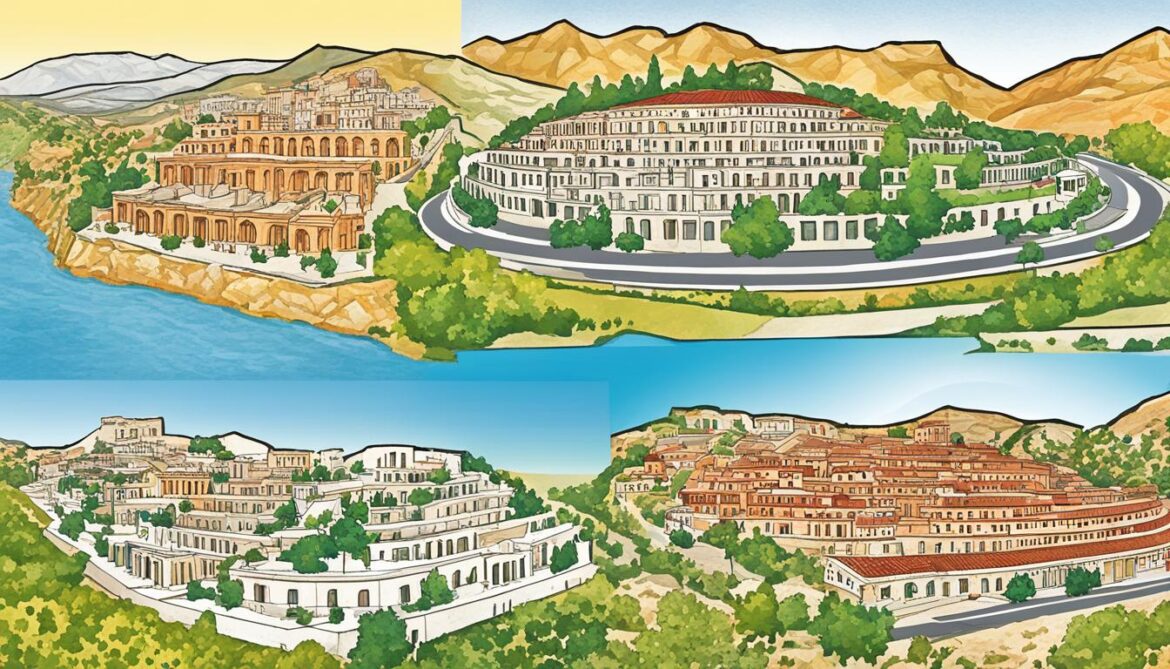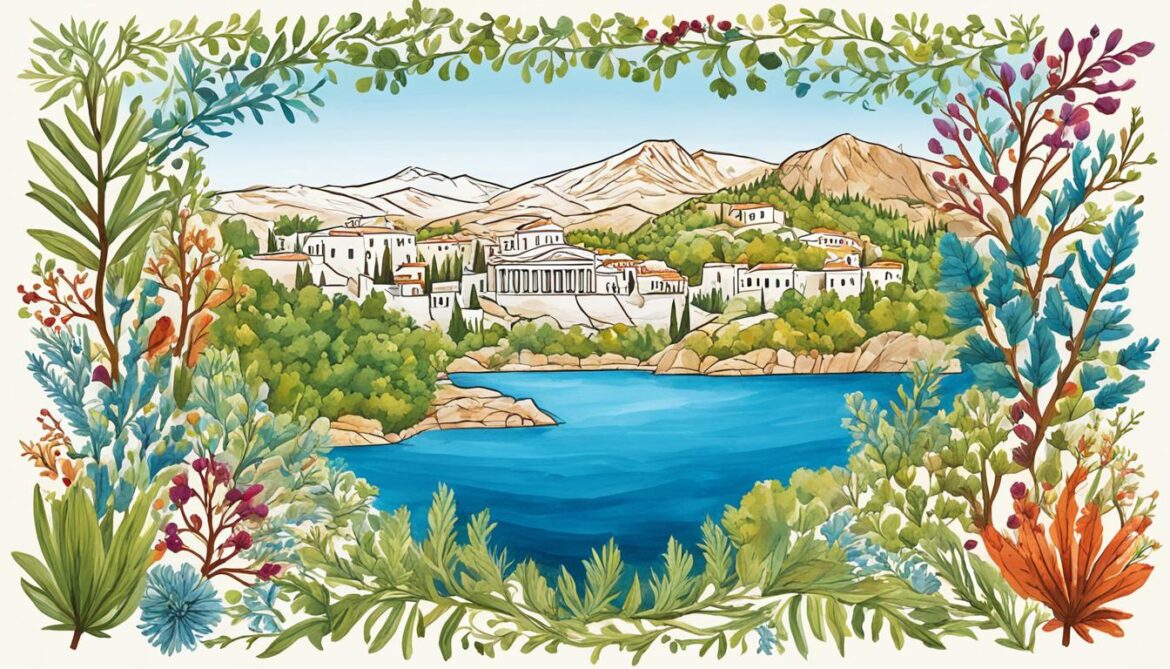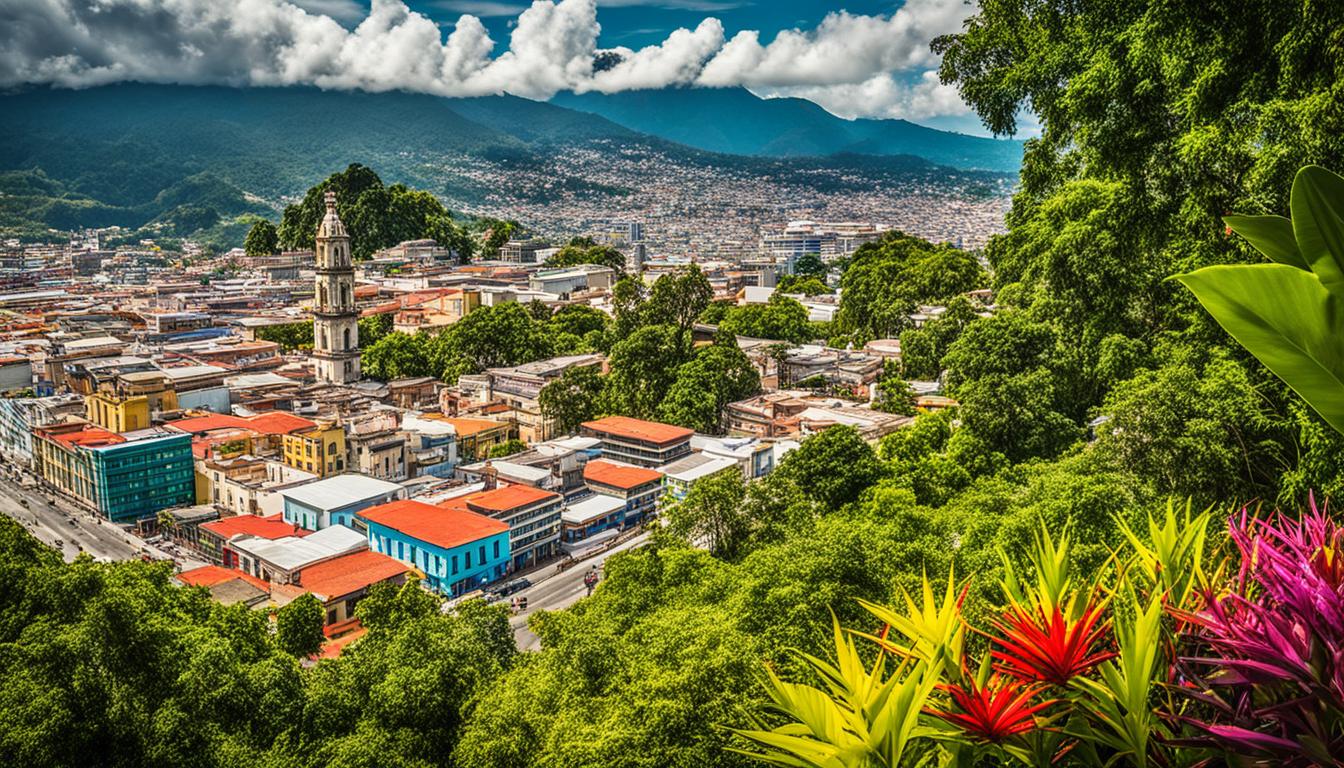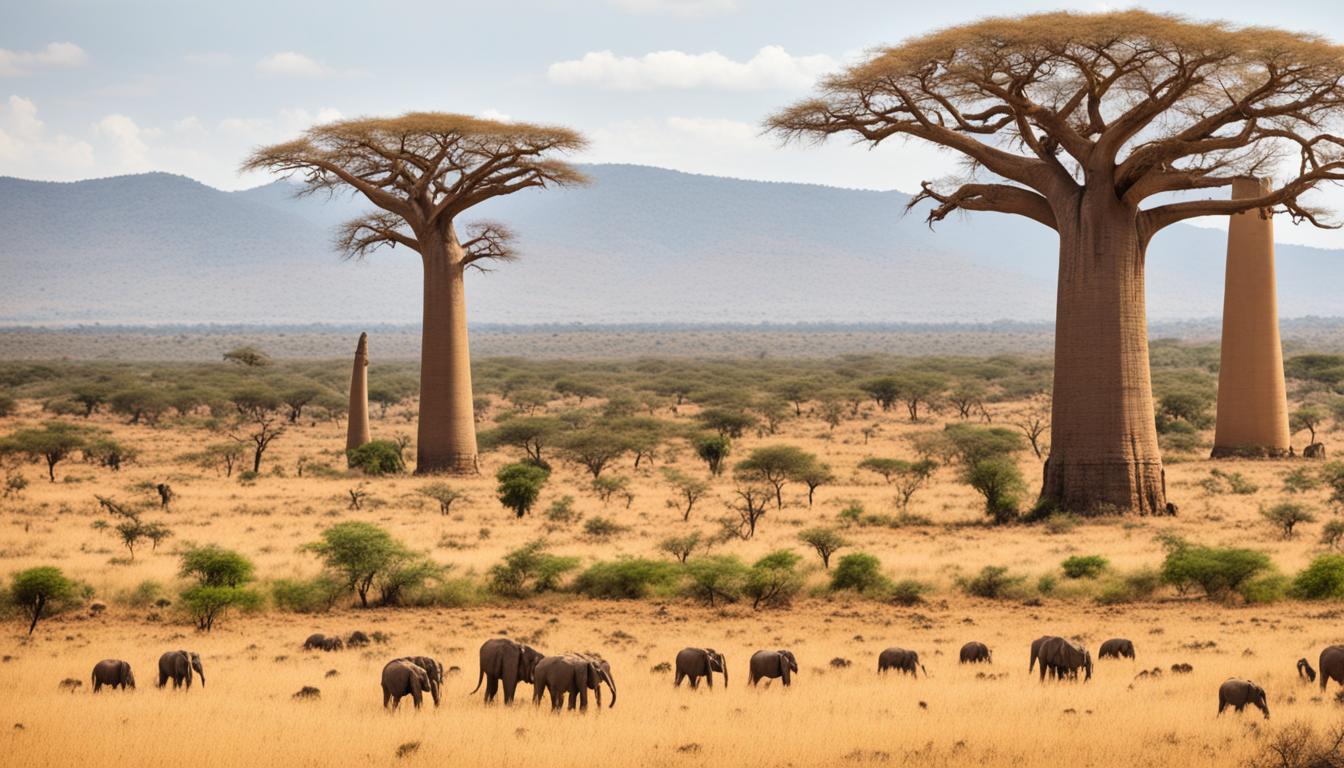Greece Biodiversity and the Built Environment
Did you know that Greece is home to one of the most biodiverse landscapes in Europe? With its diverse landscapes, extensive natural areas, and thousands of islands, Greece boasts high species diversity and is a haven for many endemic plant and animal species. The preservation of Greek biodiversity and the integration of sustainable practices in architecture and urban planning are of utmost importance to protect this unique ecosystem.
Key Takeaways:
- Greece is one of the most biodiverse countries in Europe, with diverse landscapes and numerous islands.
- The preservation of Greek biodiversity is crucial to protect endemic plant and animal species.
- Sustainable architecture and ecological design play a vital role in preserving biodiversity in Greek cities.
- Urban planning should consider the integration of green infrastructure to support biodiversity in the Greek environment.
- Sustainable development practices aim to ensure the long-term conservation of Greek biodiversity and the promotion of a sustainable built environment.
The Importance of Greece’s Biodiversity
Greece’s biodiversity is of great importance due to its high species diversity and presence of many endemic species in Greece. The country’s natural areas in Greece, diverse landscapes, and thousands of islands contribute to the richness of Greek biodiversity.
The extensive natural areas in Greece provide habitats for a wide range of plants and animal species, supporting a high variety of ecosystems. This rich biodiversity is a testament to the outstanding ecological value of the country.
The presence of endemic species in Greece is particularly noteworthy. These are species that are found exclusively within a specific geographic region or habitat, adding to the uniqueness and ecological significance of Greek biodiversity. The preservation and protection of these endemic species are crucial for maintaining the country’s natural heritage.
Moreover, Greek biodiversity plays a vital role in contributing to the aesthetic and cultural value of Greek landscapes. The diverse natural areas, from the lush forests to the stunning coastlines, provide breathtaking views and a sense of connection to the natural world. The beauty and cultural significance of these landscapes have been a source of inspiration for artists, writers, and philosophers throughout history.
Laws and Strategies for Biodiversity Conservation in Greece
Greece has taken significant steps to protect its rich biodiversity through the implementation of robust biodiversity conservation laws and the establishment of management bodies for protected areas. These efforts have strengthened the legal framework for biodiversity conservation in the country.
One notable initiative is the National Biodiversity Strategy, which provides a comprehensive framework for improving biodiversity knowledge and status in Greece. This strategy is supported by an action plan that aims to integrate biodiversity considerations into various sectoral policies.
The establishment and expansion of the Natura 2000 network is another important aspect of biodiversity conservation in Greece. The Natura 2000 network is a network of protected areas established under the European Union Birds and Habitats Directives. It includes a wide range of habitats and species of European importance. The expansion of this network in Greece has contributed to the improvement of habitat conservation status in recent years.
In summary, Greece has put in place biodiversity conservation laws, such as the National Biodiversity Strategy, and has expanded the Natura 2000 network to protect and preserve its unique biodiversity. These efforts are crucial to ensure the long-term conservation of Greece’s natural heritage.
Challenges in Biodiversity Management and Conservation
Despite the progress in biodiversity conservation, Greece faces various challenges in the management and conservation of its diverse ecosystems. These challenges require strategic approaches and collaborative efforts to ensure the long-term preservation of the country’s unique biodiversity.
Lack of Management Plans for Protected Areas
One major challenge is the absence of comprehensive management plans for protected areas in Greece. While the country has expanded its network of protected areas, these areas are not effectively managed due to the lack of formalized plans. Currently, only a small portion of the protected area network has management plans in place, hindering the conservation efforts for these important habitats and species.
Capacity and Awareness
Improving capacity and raising awareness among authorities and the public is crucial for successful biodiversity management in Greece. Capacity building programs should be implemented to enhance the skills and knowledge of those responsible for managing protected areas and enforcing conservation laws. Additionally, public awareness campaigns can help educate the local communities about the value of biodiversity and the role they play in its conservation.
Illegal Construction and Biodiversity
Illegal construction, particularly in coastal zones and forest areas, poses a significant threat to biodiversity in Greece. Unauthorized construction projects destroy habitats, disrupt ecosystems, and fragment wildlife populations. Strict enforcement of construction regulations and penalties for illegal activities are essential to protect sensitive ecosystems and prevent further harm to biodiversity.
Spatial Planning and Biodiversity
The integration of biodiversity concerns into spatial planning is vital for sustainable development and effective biodiversity conservation. By incorporating biodiversity considerations into land-use plans, urban development projects, and infrastructure initiatives, Greece can ensure that spatial decisions are made in harmony with the conservation and restoration of natural habitats. Spatial planning that takes into account the ecological needs of different regions can contribute to the effective management and protection of diverse ecosystems.
Sustainable development requires a holistic approach that combines environmental conservation, social well-being, and economic prosperity. By integrating biodiversity concerns into spatial planning, Greece can create a balanced and sustainable built environment that benefits both people and nature.

Ecological Diversity in Greek Ecosystems
Greece, located in the Mediterranean biogeographical region, is known for its remarkable ecological diversity. The topographical diversity of the country, with its mountains, agricultural landscapes, wetlands, and extensive coastline, contributes to the richness of Greek ecosystems.
Greece’s mountains are home to a wealth of species and ecosystems. The high altitude, varied climate, and diverse vegetation create favorable conditions for biodiversity. These mountains serve as important habitats for numerous plant and animal species, many of which are endemic to Greece. The rugged terrain and rocky slopes support unique ecosystems that play a vital role in preserving biodiversity.
In addition to mountains, Greece is characterized by its agricultural ecosystems. The country’s fertile plains and valleys are cultivated with a variety of crops, including olives, grapes, and wheat. These agricultural landscapes provide habitats for a wide range of species, such as birds, insects, and small mammals. Traditional farming practices, such as crop rotation and the use of natural fertilizers, contribute to the sustainability of these ecosystems.
Greek wetlands are another crucial component of the country’s ecological diversity. Wetlands, including lakes, rivers, and marshes, support a rich array of plant and animal life. They serve as breeding grounds for migratory birds, nurseries for fish, and natural filters for water purification. Greek wetlands also play a vital role in flood prevention and groundwater recharge.
Finally, Greece’s extensive coastline and numerous islands contribute significantly to its ecological diversity. The coastal and marine ecosystems of Greece are home to a remarkable variety of marine species, including fish, seagrasses, and coral reefs. These ecosystems provide important habitats and feeding grounds for marine life, and they offer opportunities for recreational activities such as diving and snorkeling.
The Ecological Diversity of Greek Ecosystems:
| Ecosystem | Main Features | Biodiversity Highlights |
|---|---|---|
| Mountains | High altitude, varied climate, diverse vegetation | Home to numerous endemic species; unique ecosystems |
| Agricultural Landscapes | Fertile plains and valleys; cultivation of various crops | Habitats for diverse species; sustainable farming practices |
| Wetlands | Lakes, rivers, marshes; water purification, flood prevention | Breeding grounds for migratory birds; biodiversity hotspots |
| Coastal and Marine Ecosystems | Extensive coastline, numerous islands; diverse marine life | Rich array of fish species, seagrasses, and coral reefs |

The ecological diversity of Greek ecosystems is a testament to the country’s natural beauty and importance for biodiversity conservation. The mountainous landscapes, agricultural ecosystems, wetlands, and coastal areas collectively contribute to the conservation of a wide range of plant and animal species. Preserving and protecting these ecosystems is essential to maintain the ecological balance and ensure sustainable development in Greece.
Threats to Greek Biodiversity
Greek biodiversity is faced with various threats that jeopardize the delicate balance of ecosystems and put numerous species at risk. These threats include:
Habitat Fragmentation
Habitat fragmentation is a major concern, particularly in mountainous regions, where it leads to the loss and fragmentation of natural habitats. One of the primary causes of habitat fragmentation is overgrazing, which results in the degradation of shrub and herbaceous vegetation, leading to a less diverse and resilient habitat.
Intensive Farming and Monocultures in Agricultural Areas
The expansion of intensive farming practices and the prevalence of monocultures in agricultural areas threaten Greek biodiversity. Intensive farming techniques often involve the use of agrochemicals, disturbing the natural balance of ecosystems and diminishing habitat quality. Monocultures, which involve the large-scale cultivation of a single crop, lead to the loss of biodiversity by reducing habitat diversity and availability for native species.
Drainage and Pollution in Wetlands
Wetlands, vital ecosystems that support a wide array of plant and animal species, are susceptible to drainage and pollution caused by human activities. Urbanization, agriculture, and industrial development contribute to the degradation of wetlands through drainage for land conversion and the discharge of pollutants into water systems. These harmful activities severely impact the delicate balance of wetland ecosystems and threaten the survival of numerous species.
Human Activities in Coastal and Marine Areas
Coastal and marine ecosystems face significant threats due to human activities. Climate change exacerbates the challenges faced by these ecosystems, resulting in rising sea levels, increased water temperatures, and the acidification of marine habitats. Coastal areas are particularly vulnerable to the negative impacts of tourism and urban development, which can lead to habitat destruction, pollution, and the overexploitation of marine resources.
| Threat | Description |
|---|---|
| Habitat Fragmentation | Loss and fragmentation of natural habitats, especially in mountainous regions |
| Intensive Farming and Monocultures | Degradation of biodiversity through intensive farming techniques and single-crop cultivation |
| Drainage and Pollution in Wetlands | Disruption and contamination of wetland ecosystems through drainage and pollution |
| Human Activities in Coastal and Marine Areas | Destructive impacts of tourism, urbanization, and overexploitation on coastal and marine ecosystems |

These threats call for urgent action to safeguard Greek biodiversity. Conservation efforts, policy interventions, and public awareness are crucial in addressing these challenges and ensuring the preservation of Greece’s unique and diverse natural heritage.
Endemic Species and Conservation Efforts
Greece is home to many endemic species, with approximately 22% of plant species and 17% of animal species being endemic. The conservation of these endemic species in Greece is crucial for preserving the country’s unique biodiversity.
One notable example of an endangered species in Greece is the loggerhead sea turtle, scientifically known as Caretta caretta. These magnificent creatures nest in Greece and face numerous threats to their survival.

The loggerhead sea turtle (Caretta caretta) is considered one of the most endangered marine turtle species globally. In Greece, efforts to protect nesting areas and implement conservation measures are critical to its survival.
Conservation measures include strict regulations to protect nesting sites, monitoring nest success rates, and addressing threats such as pollution, climate change, and coastal development.
Conservation Measures for Birds in Greece
Conservation efforts also extend to the avian population in Greece, as various bird species face population declines.
- The conservation of Greek endemic species is a priority, as they are unique to Greece and their loss would be irreversible.
- Habitat preservation and restoration projects aim to create suitable breeding and foraging grounds for birds.
- Monitoring and research initiatives help track bird populations and identify areas in need of conservation actions.
- Public awareness and education campaigns promote bird conservation and encourage biodiversity-friendly practices.
These conservation measures for birds are crucial for maintaining a healthy avian ecosystem in Greece and ensuring the survival of vulnerable species.
| Endemic Species | Conservation Status |
|---|---|
| Greek Laurel (Laurus nobilis) | Near Threatened |
| Mediterranean Monk Seal (Monachus monachus) | Critically Endangered |
| Prespa Trout (Salmo peristericus) | Critically Endangered |
| Konstantinidis’ Sweet Vetch (Vicia konstantinidis) | Endangered |
The table above highlights some of the endemic species in Greece and their conservation statuses.
The Role of Forests in Biodiversity Conservation
Forests play a crucial role in the conservation of forest biodiversity in Greece. These diverse ecosystems are home to a wide variety of plant and animal species, including those that are protected and endemic to the region. The rich biodiversity found within the forests contributes to the overall ecological balance and resilience of Greece’s natural habitats.
However, forests in Greece are facing significant challenges, such as forest degradation. Coastal and low-altitude forests have experienced degradation due to factors like urbanization and conversion into agricultural land. This loss of forest habitat is not only detrimental to the unique plant and animal species that call these forests home, but it also disrupts the overall balance of the ecosystem.
In addition to supporting biodiversity, forests also play a crucial role in mitigating and adapting to climate change. They act as carbon sinks, absorbing and storing carbon dioxide from the atmosphere, which helps to reduce greenhouse gas emissions and mitigate the effects of climate change. Furthermore, the forest habitats within Greece’s Natura 2000 network are particularly important for the conservation of forest biodiversity and are protected to ensure their long-term survival.
Overall, the conservation and protection of forest biodiversity in Greece is essential for maintaining the ecological integrity of the country’s natural landscapes. Efforts to address forest degradation, preserve forest habitats, and integrate sustainable practices in forestry management are crucial for the long-term survival of these vital ecosystems.

| Challenges | Solutions |
|---|---|
| Forest degradation due to urbanization and conversion into agricultural land | Implement sustainable forest management practices, promote reforestation and afforestation |
| Loss of forest habitat and disruption of ecological balance | Strengthen forest protection measures, establish more protected areas |
| Impact of climate change on forests | Implement measures to enhance forest resilience, promote forest conservation as part of climate change mitigation and adaptation strategies |
“The conservation and protection of forest biodiversity in Greece is essential for maintaining the ecological integrity of the country’s natural landscapes.” – Forest Biodiversity Expert
Urban Biodiversity Management in Greece
Greece acknowledges the significance of managing urban biodiversity and has implemented various green infrastructure initiatives within its cities. By integrating biodiversity considerations into urban planning processes, Greece aims to preserve green areas and create habitats for urban wildlife.
The preservation of urban biodiversity in Greece plays a vital role in enhancing the quality of life for its citizens. Green spaces within cities provide numerous benefits, including improved air quality, reduced urban heat island effect, and enhanced mental well-being.
“Urban areas are not just concrete jungles, but they can also be havens for wildlife. By incorporating green infrastructure, such as parks, rooftop gardens, and street trees, Greek cities can support urban biodiversity and create more sustainable living environments.”
Green infrastructure, such as parks, green roofs, and urban forests, can serve as valuable habitats for various plant and animal species. These initiatives also promote the connectivity of green spaces, allowing for the movement of wildlife within urban areas.
Challenges in Urban Biodiversity Management
- The need for capacity building: Adequate knowledge and skills among urban planners, policymakers, and community stakeholders are essential for effective urban biodiversity management. Training programs and workshops can help build the necessary capacity to address the complex challenges.
- Limited public participation: Engaging the public in urban biodiversity management is crucial for long-term success. Encouraging citizen involvement, promoting awareness campaigns, and establishing citizen science initiatives can foster a sense of ownership and responsibility among local communities.
- Balancing urbanization and biodiversity conservation: As cities continue to grow, finding a balance between urban development and biodiversity conservation becomes increasingly challenging. Integrating biodiversity considerations into urban planning processes is essential to minimize the negative impacts of urbanization on natural ecosystems.
Overcoming these challenges requires collaborative efforts among relevant stakeholders, including local authorities, environmental organizations, and the public. By recognizing the importance of urban biodiversity and implementing strategic measures, Greece can create sustainable and resilient cities that prioritize nature and human well-being.

Sustainable Development and Biodiversity Conservation
Greece is committed to sustainable development and recognizes the importance of integrating biodiversity concerns into spatial planning. By incorporating sustainable design principles into the built environment, Greece aims to minimize the impact on biodiversity and foster a harmonious relationship between nature and infrastructure.
The country’s efforts align with the global sustainable development goals, which emphasize the significance of biodiversity conservation for a sustainable future. By incorporating biodiversity concerns into spatial planning, Greece aims to achieve a balanced and resilient ecosystem that supports both human development and the preservation of natural habitats.
“Integrating biodiversity concerns into spatial planning is crucial for achieving sustainable development in Greece. By considering the ecological needs of an area during the planning process, we can ensure the long-term preservation of biodiversity and create sustainable communities that thrive in harmony with nature.” – Environmental Planner, Greek Ministry of Environment and Energy
To illustrate the integration of biodiversity concerns in spatial planning, consider the following example table:
| Spatial Planning Measures | Benefits |
|---|---|
| Establishment of green corridors | Facilitates wildlife movement and promotes biodiversity connectivity between fragmented habitats |
| Inclusion of green spaces in urban areas | Enhances urban biodiversity, provides ecosystem services, and improves residents’ quality of life |
| Promotion of sustainable transportation | Reduces carbon emissions, mitigates habitat fragmentation, and supports sustainable urban development |
By implementing these spatial planning measures, Greece aims to achieve a balance between urban development and biodiversity conservation. The integration of biodiversity concerns in spatial planning is essential for creating sustainable communities that prioritize the preservation and restoration of natural ecosystems.
Conservation in the Built Environment
The built environment plays a significant role in biodiversity conservation. Sustainable design practices, such as the utilization of green roofs, vertical gardens, and permeable paving, help mitigate the negative impact of urbanization on natural habitats. These innovative solutions provide opportunities for biodiversity to thrive within urban areas, contributing to a healthier and more sustainable built environment.

The conservation efforts in the built environment not only benefit local ecosystems but also provide numerous advantages for human well-being and resilience. Green spaces in urban environments promote mental and physical health, reduce urban heat island effects, and improve urban stormwater management.
Furthermore, the integration of sustainable design and conservation principles in the built environment aligns with the global sustainable development goals, particularly Goal 11: Sustainable Cities and Communities. By prioritizing the preservation and enhancement of biodiversity, Greece contributes to the global efforts in achieving a more sustainable and inclusive future.
Conclusion
Greece’s biodiversity is of great value and importance, with its diverse landscapes and extensive natural areas hosting high species diversity and many endemic species. The country has made significant progress in biodiversity conservation, with strengthened legal frameworks and expanding protected areas. However, ongoing challenges such as the lack of management plans for protected areas and illegal construction pose threats to Greek biodiversity.
To ensure the conservation of Greek biodiversity and promote a sustainable built environment, it is crucial to integrate biodiversity concerns into spatial planning and sustainable development practices. Efforts should be made to address the current challenges through capacity building, public participation, and enforcement of regulations. By doing so, Greece can enhance its biodiversity conservation efforts and secure a sustainable future for its natural heritage.
In the future, it is essential to continue prioritizing the preservation and sustainable use of Greek biodiversity. This includes implementing comprehensive management plans for protected areas, enhancing the awareness and understanding of biodiversity among authorities and the public, and integrating biodiversity considerations into urban planning and infrastructure development. By working together and embracing sustainable development practices, Greece can pave the way for a harmonious coexistence between biodiversity and the built environment.
FAQ
What makes Greece’s biodiversity significant?
Greece’s biodiversity is significant due to its high species diversity and the presence of many endemic plant and animal species. The diverse landscapes, extensive natural areas, and thousands of islands contribute to the richness of Greek biodiversity, which has high aesthetic and cultural value.
What laws and strategies are in place for biodiversity conservation in Greece?
Greece has implemented laws on biodiversity conservation and management bodies for protected areas to strengthen its legal framework. The country has also developed the National Biodiversity Strategy and related action plan, which provide a comprehensive framework for improving biodiversity knowledge, integrating biodiversity into sectoral policies, and expanding the Natura 2000 network for habitat conservation.
What are the challenges in biodiversity management and conservation in Greece?
One major challenge is the lack of management plans for protected areas, which cover only a small portion of the network. There is also a need to improve capacity and awareness among authorities and the public. Additionally, illegal construction, particularly in coastal zones and forest areas, poses a threat to biodiversity and hinders habitat and species protection.
What are the ecological diversity and ecosystems in Greece?
Greece belongs to the Mediterranean biogeographical region and has diverse topography, including mountains, agricultural landscapes, wetlands, and coastal areas. The country’s mountains host a wealth of species and ecosystems, while agricultural ecosystems and wetlands are important for supporting biodiversity. The extensive coastline and many islands contribute to the ecological diversity of coastal and marine ecosystems.
What are the main threats to Greek biodiversity?
Greek biodiversity faces threats such as habitat fragmentation in mountainous regions due to overgrazing and degradation of vegetation. Intensive farming, monocultures, and the abandonment of traditional mountain agriculture pose threats in agricultural areas. Wetlands are affected by drainage and pollution, and coastal and marine ecosystems are impacted by climate change, tourism, and overexploitation of resources.
What endemic species are found in Greece, and how are they conserved?
Greece is home to many endemic species, with approximately 22% of plant species and 17% of animal species being endemic. The conservation of these species is important for preserving Greek biodiversity. Notable examples include the loggerhead sea turtle (Caretta caretta), which nests in Greece and is considered endangered. Conservation efforts include protecting nesting areas and implementing measures to address threats to the species. Conservation measures for birds are also important, given the decline in common and forest bird populations.
What role do forests play in biodiversity conservation in Greece?
Forests play a crucial role in biodiversity conservation in Greece. They are home to a variety of plant and animal species, including protected forest animals. However, coastal and low-altitude forests have experienced degradation due to urbanization and conversion into agricultural land. Forest biodiversity is also important for mitigating and adapting to climate change. Many forest habitats are included in the Natura 2000 network to ensure their protection and conservation.
How is urban biodiversity managed in Greece?
Greece recognizes the importance of managing urban biodiversity and has been implementing green infrastructure initiatives in cities. Biodiversity considerations are being integrated into urban planning processes to ensure the preservation of green areas and the creation of habitats for urban wildlife. However, challenges exist in urban biodiversity management, such as the need for capacity building and public participation.
How does Greece promote sustainable development and biodiversity conservation?
Greece is committed to sustainable development and recognizes the importance of integrating biodiversity concerns into spatial planning. Sustainable design principles are being applied in the built environment to minimize the impact on biodiversity. These efforts align with the global sustainable development goals, which emphasize the importance of biodiversity conservation for a sustainable future.
What ongoing challenges exist in Greek biodiversity conservation, and what are the future prospects?
Greece has made significant progress in biodiversity conservation but faces challenges such as lack of management plans for protected areas and illegal construction. The integration of biodiversity concerns into spatial planning and sustainable development practices will contribute to the conservation of Greek biodiversity and the promotion of a sustainable built environment.







